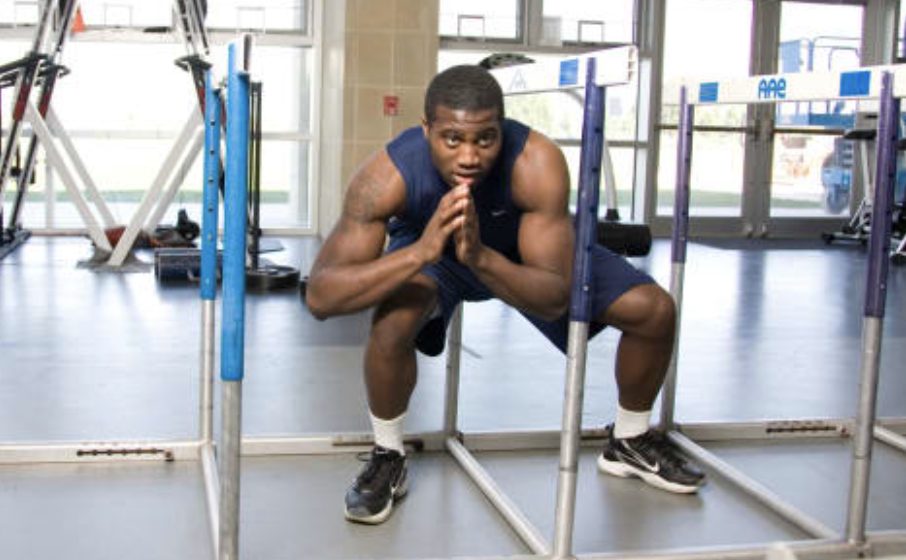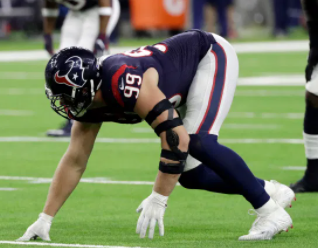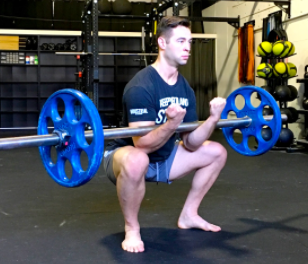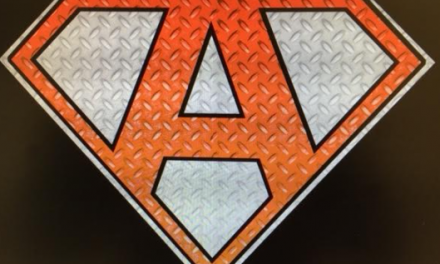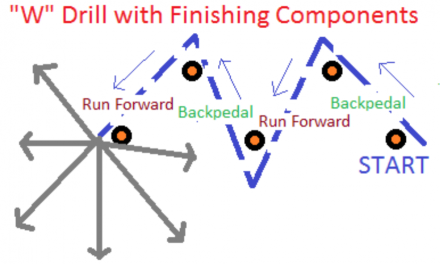There are a lot of different perspectives on how to approach day-after-game workouts. These workouts are difficult to organize because there are many questions that have to be answered before making programming decisions. All programming considerations should come down to basically four big questions…
- How well are the players recovering?
- How is the overall team health?
- Do any athletes need personalized training?
- What are we preparing for next?
HOW WELL ARE THE PLAYERS RECOVERING?
It is a good idea to gauge how sluggish athletes are each day and to see if there are any patterns. Sometimes players and teams have bad practices and games because they have not recovered from the proceeding days or weeks. When I was a high school player I still remember being tired on a Wednesday practice during the first week of the playoffs. We had played a very good opponent (Cincinnati St. Xavier HS) in week 10 and I never recovered. We ended up playing poorly, losing that playoff game, and I still wonder if my teammates were feeling as tired as I was.
Most high school athletes (this was true for me also) struggle with recovery because of improper nutrition, inadequate hydration, and a lack of sleep. Most athletes do not have an overuse problem but really have an under-recovery problem. Even though we can only do so much about these problems, we can adjust practice and training sessions to somewhat mitigate their recovery.
In terms of recovering from games, my philosophy is now drastically different than when I first started coaching. Previously, I organized our Saturday schedule around the coaches more than around the players. We would have the players arrive early to watch film first and then workout afterwards. The reason why I did this was because I wanted to get the previous night’s game finished completely before we moved onto game-planning. That led to the decision to have the kids watch film first and then workout. I have done a complete 180 on this now. I do not care as much about the coaches’ schedules as the athletes’ schedules. I want the players to be able to sleep in, eat breakfast, and have some time before they train.
I am not sure about your athletes but I can understand why players are tired and do not want to train hard on Saturday mornings. When we start their workouts, they are about 11 hours from when they finished the game. That is not even close to enough time to recover from a hard game and then turn around and do a hard workout.
Our games currently end around 10 pm (we throw the ball about 45 times a game and try to run as many plays as possible) so our players do not get home and in bed until midnight. They go get food and see their friends and it takes them some time to decompress. I do not want the athletes to feel like they have to run home and go straight to bed. Even if we told them to do this they still would not. If we have them get to school on Saturdays around 8 am (which I used to do) instead of 9 am, then they will not get the minimum of 8 hours of sleep that we want. In terms of the coaches, they get their previous game film graded and then start working on the next opponent. When the kids get done with their workout around 10 am, the coaches stop what they are doing and watch the film with the players. Those extra hours of sleep add up when you have to win 16 games to win the Ohio State Championship and when the season starts on August 1st and ends the first week of December.
Some processes that can help reduce recovery time are…
- Static stretch after the game. I know that the logistics of this is hard and most coaches do not want to do it but it will allow Saturday workouts to be at a higher intensity. All of the coaches that I have ever worked with have not let me stretch the players after the game but there are some programs that do. One of the teams that I trained lost the state championship and the team that beat us stretched after winning the state championship. That was salt in the wound for me. If you play on Saturday and have Sunday off, I would definitely stretch the kids after the game because they will not think about taking care of their bodies until Monday.
- If the players look sluggish during the week, it might be a good idea to decrease practice intensity or shorten practice. With high school athletes, I think it is better to shorten practice while keeping the same intensity to keep a high level of concentration.
- After practice ice baths will help to decrease recovery time. When NFL and NCAA teams had two-a-days, they would have their athletes get into ice baths immediately after the first practice to begin the recovery for the second practice. This is a good idea because decreasing body temperature is a key component to endurance and recovery and the following podcast goes into this in detail: Supercharge Exercise Performance & Recovery With Cooling
HOW IS THE OVERALL TEAM HEALTH?
There is a reactive and a proactive component to this conversation. The reactive component is that Saturday programming should not be the same every week. If you just played a very hard game against a very physical opponent, players are going to struggle through a Saturday workout. If your athletes only played a half against a bad team, the Saturday workout should be much harder. A simple way to think about it is make the total sum of Friday’s and Saturday’s energy output and intensity to be the same each weekend. A hard game should lead to an easier workout and an easier game should lead to a harder workout. A game might be so hard that the Saturday workout should just be Yoga, Foam Rolling, and/or a pool workout. I have done this in the past after games where we were very beat up.
There is also a proactive component to this. USA Track & Field recommends that athletes should take a four day weekend of complete rest every four to six weeks. We obviously cannot take a 4 day weekend but the point is well taken. To try to get an extended weekend, you can cancel workouts on a weekend when you play an easy opponent. The Friday game will be easy, and then the remainder of the weekend can be all rest. The other good thing about this is the Friday night film against a terrible opponent is usually not very helpful for the coaches or the players. On weekends like that, I would recommend that you stretch the players after the game because if you do not, they will go the entire weekend without stretching.
In terms of the playoffs and if you are going to make a mistake, make sure that your players are too fresh. Nobody has won playoff games with well-conditioned but tired legs. The goal is to get to the starting line with healthy athletes that can go hard the entire game. The hard part about this is trying to balance how much practice your team needs to be prepared at the same time limiting practice to be fresh for a tough game. This is where theory meets practicality and this falls under the art of coaching more than the science of coaching.
DO ANY ATHLETES NEED PERSONALIZED TRAINING?
After a very hard game, athletes are going to have different needs. If you played a Wing-T team, the defensive linemen are going to feel much different than when playing a Spread passing team. Your wide receivers will feel much different if you ran the ball 80% of the time versus passing the ball 80% of the time.
Another consideration is that some athletes have nagging injuries and others do not. This is where your athletic trainer needs to be involved. To keep the kids healthy, the coaches and trainers have to communicate. The best trainers I have worked with have the workouts posted on their wall and they know everything that is going on at workouts. I come in on Saturday and they would have a spreadsheet of the athlete, their issues, and their thoughts on what should be modified. We would have a five minute conversation where we would discuss each kid and my thoughts on how we could also modify each player’s workout. I would leave the training room and everyone would be on the same page. When athletes know that their coaches and trainers are working together it is impossible for them to get out of things and they know that everyone is trying to help them. I have always thought that we should constantly figure out ways for kids to get into stuff instead of out of stuff.
To illustrate how important personalizing is, I need to discuss one of my biggest coaching regrets. I had a player named Luis who played a hybrid fullback position for us. Luis was a very good football player who was essential to us getting to the state championship game. In the state semi-finals, we ran “Inside Zone Kick” a lot and Luis had to kick out a defensive end who went to Michigan State. Luis did his job because our tailback had 45 carries for 250 yards. After that game, we did a terrible job of getting Luis ready for the State Championship. We treated him like any other player and he practiced full go the whole week. We should have limited his reps and maybe even given him a day off because he never recovered physically. Because of that he struggled in the State Championship because he was battered. It was our fault that he did not recover and we ended up losing when our opponent scored with 90 seconds left. That’s a rough way to lose a State Championship.
WHAT ARE WE PREPARING FOR NEXT?
Some coaches plan their week to go from Monday through Saturday. Personally I like to think that the schedule goes from Saturday through Friday. The reason why I think this way is because Saturday starts the process of beating the next opponent and the whole point of Saturday’s workout is to get the players ready for Monday’s practice. If the players come to Monday’s practice still beat up and not ready to practice full-go, the rest of the week is going to have to change to accommodate the lengthened recovery process.
Who the next opponent is and what part of the season we are in will also help make these decisions for us. If the next opponent will be easy, then “training through” that game and Saturday is a good idea. If we are getting ready for a playoff game, then the workout will be a little lighter because we will have to be 100% every game. In the Ohio playoffs, we can lose at any time so we have to be completely ready every week.
I like to make Saturday workout decisions more out of science than emotions. I am not a fan of making workouts harder because we lost or making them easier because we won. Winning is the reward and losing is the consequence. For me, if the kids are beat up then they are beat up and they are not more beat up or less beat up because we won or lost. I know that there are times that coaches have to make a point but that should be the exception instead of the rule.
PROGRAMMING
The following is a breakdown of my current one-hour Saturday morning workout. My goal is to make them sweat a lot and to get their bodies feeling good again.
Warm-Up & Static Stretching (15 minutes)
I have had teams that want to jog first, then static stretch, and then go into their dynamic warm-up. They feel like they are too stiff to try to do anything athletic and want to static stretch first. I have had other teams that want to do the dynamic warm-up and then static stretch. The constants are that we will get the body temperature up, get the nervous system firing, and static stretch.
Conditioning (5 minutes)
The goal of this period is to sweat and to prepare to lift weights. The goal is not to try to kill the kids and see how far they can push themselves. I have used the following types of conditioning in the past:
Fartlek Runs
These runs consist of up-tempo periods and jogging periods. We usually do 45 second jog periods, 15 second sprint periods, and repeat for five minutes. Even doing five minutes of this will make well-conditioned athletes tire quickly.
1-1 Ratio Runs
In this conditioning activity, athletes run 100 yards in 15-20 seconds. Lineman will hit around 20 seconds and everyone else will hit somewhere between 15-20 seconds. It is called a 1-1 Ratio Run because the athletes will get 20 seconds rest before they go again. We run anywhere from 6-10 of them and it is determined by the energy output from the night before.
Weight Lifting (20 minutes)
I do not think that it helps athletes to have a heavy lifting session on Saturdays. It is really hard to lift heavy weights 11 hours after playing a game. Not only is the body tired but the nervous system will be taxed to a point where the motor neurons will not fire their motor units correctly. That all being said, I like to do one of two types of lifting. One is a heavier functional lift where they are still lifting somewhat heavy and going through some multi-joint exercises without maxing out.
The other potential option is a “3 Way Fitness Lift”. In this workout, the players are broken up in groups of three. They will do each exercise for a particular amount of time and then they will switch to the next exercise. This is basically a continuous movement lifting session that would fall into the High-intensity-interval-training (HIIT) category.
Lower Body Stretching (10-15 minutes)
Here are some potential options for stretching the lower body:
PNF (Proprioceptive Neuromuscular Facilitation) Stretching Routine
In this routine, an athlete will stretch for about 10 seconds, resist for about 5 seconds, and then stretch for another 15 seconds. The second stretching session should be longer than the first and the resistance portion will trick the nervous system to allow the athlete to stretch further on the second stretching portion. This stretching routine will not only make the athletes more flexible but also will make them feel like their legs are lighter. Do not use this routine before a game but it is a great routine for after a game. Remind your athletes that this is not a wrestling match to show how strong they are.
When you hear people talking about doing “Hot Yoga”, they are usually doing Bikram Yoga at an elevated temperature. This is a great routine to build coordination, balance, and flexibility. Your players will initially be terrible at it but they will get better over time.
Upper Body Stretches (5 minutes)
In football, shoulder injuries are one of the common problems we have. Even if they are not injured, athletes constantly complain about them hurting or that they have limited range of motion. Here are a couple stretches that can be done on Saturdays and these are the same stretches that quarterbacks and baseball players should be doing regularly. Some of the following stretches are programmed to open up the ulnar nerve and to stimulate blood flow while others are used for flexibility and decompression.
Coaching Points:
- Push the elbow against something so the elbow travels backward. They can use a pole, fence, or wall.
- If they do not have something to help push the elbow back, have them push their chest forward and pinch their shoulder blades.
- They can do both sides at the same time.
- If the athlete looks up, it will work even better.
- If athletes have a pinched nerve, their pinkie finger will go numb.
Coaching Points:
- The hand should be at hip height and the wrist should be at a 90 degree angle.
- If they have something to put their fingers on (pole, wall, fence), it will work better
- For the picture above, turn the left shoulder to put more pressure through the right shoulder.
- They can do both sides at the same time.
- If they have a pinched nerve, their middle finger will go numb.
Coaching Points:
- This stretch can be done in a variety of positions. The positioning of the chest and how bent the knees are will determine which part of the back is isolated.
- Tell the athletes to move around slowly until they find a “trouble spot”. When they find those spots they should stay there for a little while until moving on to find the next spot.
Coaching Points:
- The upper arm should make a 90 degree angle with the body
- The elbow should be at a 90 degree angle
- Lean the top shoulder backward while pushing the wrist towards the ground
Coaching Points:
– Try to get the fingers turned all the way backward
– Lean the hips backward to increase the stretch
SUMMARY
Here are some quick questions to be answered to program your day-after-game workouts:
– How physical was the game?
– How much did the players actually play?
– Do we need to be fresh for our next opponent?
– Does the workout need to focus more on athletic gains or recovery?
– How much should we condition?
– How much strength training can the players handle?
– Who needs their workout modified?
If you are interested in learning more you can go to the resources page on my website (https://exceleratead.com/training-theory) to find my FREE and moderately priced CoachTube Courses, Coaches Choice Videos, and a variety of other training articles and resources. My contact information is on my website so please feel free to email me with any questions.

